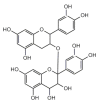Proanthocyanidins and Flavan-3-ols in the Prevention and Treatment of Periodontitis-Immunomodulatory Effects, Animal and Clinical Studies
- PMID: 33467650
- PMCID: PMC7830097
- DOI: 10.3390/nu13010239
Proanthocyanidins and Flavan-3-ols in the Prevention and Treatment of Periodontitis-Immunomodulatory Effects, Animal and Clinical Studies
Abstract
This paper continues the systematic review on proanthocyanidins and flavan-3-ols in the prevention and treatment of periodontal disease and covers the immunomodulatory effects, and animal- and clinical studies, while the other part discussed the direct antibacterial properties. Inflammation as a major response of the periodontal tissues attacked by pathogenic microbes can significantly exacerbate the condition. However, the bidirectional activity of phytochemicals that simultaneously inhibit bacterial proliferation and proinflammatory signaling can provide a substantial alleviation of both cause and symptoms. The modulatory effects on various aspects of inflammatory and overall immune response are covered, including confirmed and postulated mechanisms of action, structure activity relationships and molecular targets. Further, the clinical relevance of flavan-3-ols and available outcomes from clinical studies is analyzed and discussed. Among the numerous natural sources of flavan-3-ols and proanthocyanidins the most promising are, similarly to antibacterial properties, constituents of various foods, such as fruits of Vaccinium species, tea leaves, grape seeds, and tannin-rich medicinal herbs. Despite a vast amount of in vitro and cell-based evidence of immunomodulatory there are still only a few animal and clinical studies. Most of the reports, regardless of the used model, indicated the efficiency of these phytochemicals from cranberries and other Vaccinium species and tea extracts (green or black). Other sources such as grape seeds and traditional medicinal plants, were seldom. In conclusion, the potential of flavan-3-ols and their derivatives in prevention and alleviation of periodontal disease is remarkable but clinical evidence is urgently needed for issuing credible dietary recommendation and complementary treatments.
Keywords: Camellia sinensis; condensed tannins; cranberry; flavan-3-ols; gingivitis; gum disease; immunomodulatory; natural compounds; natural substances; periodontitis; polyphenols; proanthocyanidins.
Conflict of interest statement
The authors declare no conflict of interest.
Figures



Similar articles
-
Proanthocyanidins and Flavan-3-Ols in the Prevention and Treatment of Periodontitis-Antibacterial Effects.Nutrients. 2021 Jan 7;13(1):165. doi: 10.3390/nu13010165. Nutrients. 2021. PMID: 33430257 Free PMC article.
-
Insights into the metabolism and microbial biotransformation of dietary flavan-3-ols and the bioactivity of their metabolites.Food Funct. 2010 Dec;1(3):233-53. doi: 10.1039/c0fo00132e. Epub 2010 Nov 17. Food Funct. 2010. PMID: 21776473 Review.
-
Challenges and complexity of functionality evaluation of flavan-3-ol derivatives.Biosci Biotechnol Biochem. 2017 Jun;81(6):1055-1060. doi: 10.1080/09168451.2017.1295801. Epub 2017 Mar 27. Biosci Biotechnol Biochem. 2017. PMID: 28345490 Review.
-
Cranberry proanthocyanidins: natural weapons against periodontal diseases.J Agric Food Chem. 2012 Jun 13;60(23):5728-35. doi: 10.1021/jf203304v. Epub 2011 Nov 29. J Agric Food Chem. 2012. PMID: 22082264 Review.
-
Influence of formulation and processing on absorption and metabolism of flavan-3-ols from tea and cocoa.Annu Rev Food Sci Technol. 2011;2:125-51. doi: 10.1146/annurev-food-022510-133725. Annu Rev Food Sci Technol. 2011. PMID: 22129378 Review.
Cited by
-
Matrix Metalloproteinases in the Periodontium-Vital in Tissue Turnover and Unfortunate in Periodontitis.Int J Mol Sci. 2024 Feb 27;25(5):2763. doi: 10.3390/ijms25052763. Int J Mol Sci. 2024. PMID: 38474009 Free PMC article. Review.
-
Variability in the Qualitative and Quantitative Composition of Phenolic Compounds and the In Vitro Antioxidant Activity of Sour Cherry (Prunus cerasus L.) Leaves.Antioxidants (Basel). 2024 Apr 30;13(5):553. doi: 10.3390/antiox13050553. Antioxidants (Basel). 2024. PMID: 38790658 Free PMC article.
-
Designing of Drug Delivery Systems to Improve the Antimicrobial Efficacy in the Periodontal Pocket Based on Biodegradable Polyesters.Int J Mol Sci. 2023 Dec 29;25(1):503. doi: 10.3390/ijms25010503. Int J Mol Sci. 2023. PMID: 38203673 Free PMC article.
-
Epicatechin analogues may hinder human parainfluenza virus infection by inhibition of hemagglutinin neuraminidase protein and prevention of cellular entry.J Mol Model. 2022 Sep 16;28(10):319. doi: 10.1007/s00894-022-05310-9. J Mol Model. 2022. PMID: 36109366
-
Optimization of ultrasound-aided extraction of bioactive ingredients from Vitis vinifera seeds using RSM and ANFIS modeling with machine learning algorithm.Sci Rep. 2024 Jan 12;14(1):1219. doi: 10.1038/s41598-023-49839-y. Sci Rep. 2024. PMID: 38216594 Free PMC article.
References
Publication types
MeSH terms
Substances
Grants and funding
LinkOut - more resources
Full Text Sources
Other Literature Sources

